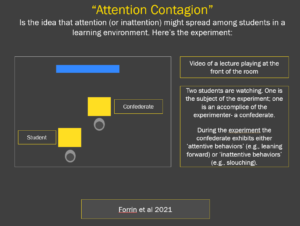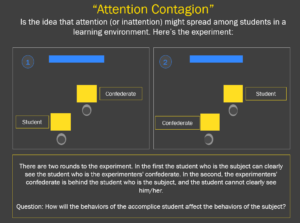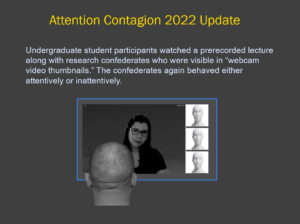01.05.24Attention Contagion: One of the Primary Drivers of Learning is Mutual, Social & Collective.


Answer: Subjects who watched the lecture with an attentive confederate:
1)Reported higher levels of attention
2)Behaved more attentively (e.g. took more notes)
3)Had better memory of the lecture content (i.e. learned more)In both cases!
‘Despite confederates not being visible, participants were still aware of whether confederates were acting attentively or inattentively, and participants were still susceptible to attention contagion. Our findings suggest that distraction is one factor that contributes to the spread of inattentiveness.’
The implications of this are pretty significant. Attention (or the lack of it) is a social phenomenon at least in part. It spreads around a classroom or any learning environment. It is to a degree mutual, social and collective.
By the way there was a later follow-up to this study…
Undergraduate student participants watched a prerecorded lecture along with research confederates who were visible in “webcam video thumbnails.” The confederates again behaved either attentively or inattentively.

Consistent with previous findings, “students who watched the lecture with attentive (vs. inattentive) confederates reported being more attentive and they learned more of the lecture content—performing 12% better on a post-lecture quiz. They also perceived the lecture as more important, suggesting that social inferences (e.g., “this lecture is important”) may undergird attention contagion.”
Reminds me of a point Peps McCrea makes in the outstanding ‘Motivated Teaching’: The greatest single influence on motivation and behavior is the individual’s perception of the shared norm of peers.

We know that attention is central to every learning task and the quality of attention paid by learners shapes the outcome of learning endeavors.
Part of attentiveness is individual. Some people are more attentive than others and have better skills/habits in terms of their attention.
But is attention also partly social? Does the environment in which students learn influence their attentiveness?
“Attention contagion” is the idea that attention (or inattention) might spread among students in a learning environment. Here’s a fascinating experiment:
Video of a lecture playing at the front of the room. Two students are watching. One is the subject of the experiment; one is an accomplice of the experimenter- a confederate.
During the experiment the confederate exhibits either ‘attentive behaviors’ (e.g., leaning forward) or ‘inattentive behaviors’ (e.g., slouching).
There are two rounds to the experiment. In the first the student who is the subject can clearly see the student who is the experimenters’ confederate. In the second, the experimenters’ confederate is behind the student who is the subject. The student cannot clearly see him/her.
Question: How will the behaviors of the accomplice student affect the behaviors of the subject?